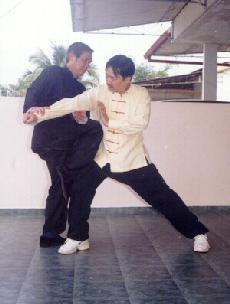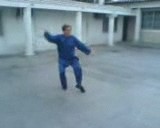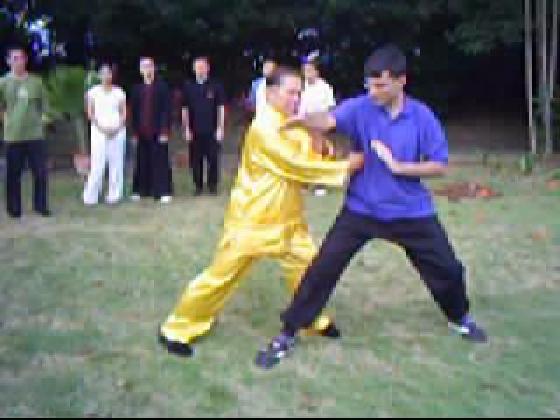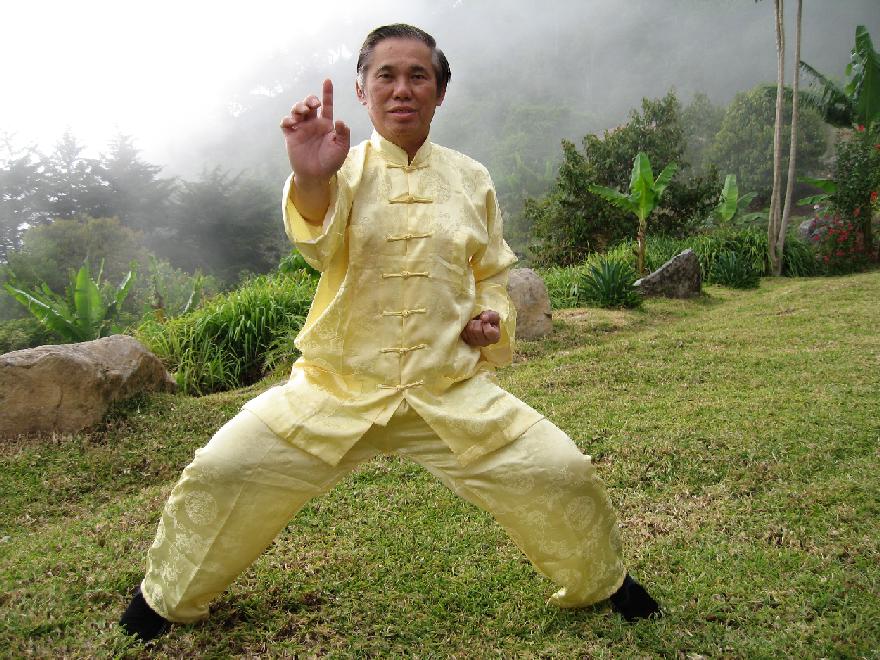March 2009 (Part 1)
SELECTION OF QUESTIONS AND ANSWERS

Sifu Robin Gamble gives a fantastic demonstration of “Flowing Water Floating Clouds” on the Blue Mountain. Please click here to view the videos.
Question 1
I've literally spent the whole weekend studying the Wahnam Tai Chi Chuan set you created, “Flowing Water Floating Clouds”. It is incredible! Please, may I ask for some history on your creation of this set and perhaps any advice on creating a Shaolin equivalent?
— Sifu Jamie, Scotland
Answer
Your question touches on the background of our Taijiquan sets.
As you probably have known, the Taijiquan set we first used in our school was the 24-Patttern Simplified Set, which was mainly from Yang Style Taijiquan.
This is an excellent set. It is short, yet it incorporates all important aspects of Taijiquan, including combat application and internal force training, though most practitioners of this set, in fact most Taijiquan practitioners today, do not know combat application or internal force.
For advanced training, Taijiquan practitioners of our school who attended my Combined Advanced Shaolin-Taijiquan Course in 2000, also learned the 108-Pattern Yang Style Set.
Nevertheless, I would like our Taijiquan practitioners to have some understanding and experience of Chen Style Taijiquan too. Therefore, I introduced the fundamental Chen Style Taijiquan set into our school, but it underwent some transformation to suit our particular needs.
At first we just called it Chen Style Taijiquan, but later to differentiate this set from other sets composed from our Taijiquan combat sequences, we named it “Flowing Water Floating Clouds”.
In my early years of teaching Wahnam Taijiquan, students first learned a basic set, from which they learned other important aspects of Taijiquan. This basic set was the 24-Pattern Simplified Taijiquan Set. But as I improved in my teaching methodology, I taught in a way how past practitioners learned, i.e. our students learned the basics first, like stances and footwork, basic movements, chi flow and exploding force.
To help our students remember these learning points better as well as practice more systematically, we linked these learning points into a set, and we call this set “White Crane Flaps Wings”. This was similar to what we had been doing in Shaolin Kungfu with the set “Lohan Asks the Way”. Hence, both our Shaolin and Taijiquan students relive what past kungfu practitioners did.
When I taught a VIP Taijiquan course to company directors and top managers, who had less time to practice than average students, I shortened “White Crane Flaps Wings” and kept only the essence. This resulted in the set “Cloud Hands”, which also reminded us how Taijiquan was first evolved by the great Zhang San Feng.
Having learnt the basic patterns, students used them for combat application. To help our Taijiquan students learn combat application systematically and effectively, I created 12 basic Taijiquan combat sequences which are parallel to the 16 basic Shaolin combat sequences.
The first three Taijiquan combat sequences are linked together to form the set “White Snake Shoots Venom”. The second three sequences form the set “Green Dragon Shoots Pearl”. The third three sequences form the set “Black Bear Sinks Hips”, and the fourth three sequences form the set “Carry Tiger Back to Mountain”.
In some courses, there was insufficient time to learn these 12 Taijiquan combat sequences, or the 16 Shaolin combat sequences. Instead of teaching only some of these 12 or 16 sequences, which would then lack comprehensiveness, I abridged the 12 or 16 sequences into 8. The result were “Yellow Bee Sucks Pollens” in Taijiquan, and “Single Tiger Emerges from Cave” in Shaolin Kungfu.
When time was even less, I condensed the 8 sequences into 4, but without neglecting their depth or comprehensiveness, and the result were the “Taijiquan Four-Sequence Four-Attack Set” and the “Shaolin Four-Sequence Four-Attack Set”. It is really incredible that these two sets contain the essence of Taijiquan and Shaolin Kungfu respectively.
A remarkable outcome of this historical background of our kungfu sets is an interesting paradox. Relatively, we pay more importance to skills than to techniques which are crystallized into sets, yet in a short time our students learn so many Taijiquan or Shaolin sets! It is worthy of note that our sets, like what actually happened in the past, were the result of our attempt to enable our students to learn more effectively and to have more benefits from their training. The sets were not created for demonstration to please spectators.

Grandmaster Wong demonstrating the application of the pattern “Throw Knee at Chess” taken from the "Flowing Water Floating Clouds" Set
Question 2
Indeed, it has left me a little disheartened because I cannot imagine a Shaolin set having such fluid and open movements that are not only combat efficient but excellent for promoting health and vitality.
Answer
As usual but unreasonably, many people may be unhappy and some may be angry when we mention that our Taijiquan students get more benefits in one year than most other Taijiquan practitioners get in ten. But this is the truth, and it can be easily verified.
How many Taijiquan practitioners today who have ten or more years of Taijiquan training, for example, have internal force or can apply Taijiquan for combat? We can proudly say that every one of our students who have practiced for a year have these two benefits. Of course, we mention this truth not because we want to glamorize ourselves or belittle others, but to help preserve genuine, traditional Taijiquan.
You would be happy to note that our Taijiquan students can achieve such remarkable result because of the successful transfer of learning from our Shaolin teaching methodology. Hence, not only you should not be disheartened, you should rejoice.
Indeed, the set you referred to, “Flowing Water Floating Clouds”, has such fluid and open movements that are excellent not just for combat but also for health and vitality. Realizing this fact is a first important step.
But do you also realize two other important points? Firstly, not many people, including those who may practice this set, realize this fact. Secondly, even if they do, they would be unable to obtain the practical benefits from this set. In other words, even if they know that this set can give them combat efficiency, health and vitality, they still would not get these benefits even when they practice this set for years.
Yet, you go a step further. You and all those who have attended my Special Shaolin Kungfu Course can compose similar sets with similar benefits. In fact you did that, albeit on a smaller scale, as an exercise in the Special Shaolin Kungfu Course you attended in 2005. You were required to compose a set from the patterns of your chosen specialized set to meet various objectives.
To compose a set like “Flowing Water Floating Clouds”, or its Shaolin equivalent or any worthy set for that matter, you need to consider three dimensions:
- Aims and Objectives
- Scope and Depth
- Resources Available
Briefly, in composing “Flowing Water Floating Clouds”, the aims and objectives were to enable advanced Wahnam Taijiquan practitioners to have a set of movements that fulfilled all major benefits of practicing Taijiquan, including good health, vitality, longevity, mental freshness, combat efficiency and spiritual joys.
The scope was that the set should be about 108 patterns long covering all the four categories of attack and defence, and the depth would cover the aspirations of advanced practitioners. As for resources, I had access to many Taijiquan classics which I could make use of, as well as my understanding and experience of Chinese martial arts.
Let us now take another example from the other end of the scale, “White Crane Flaps Wings”, which was meant for beginners.
Although it is meant to be an elementary set, I want its practitioners to experience and benefit from all major aspects of Taijiquan, including stances, footwork, body-movement, basic techniques, energy flow and combat application.
In terms of scope and depth, I intended the set to be short so that students could learn it in a relatively short time, yet they could enjoy and benefit from practicing it for life. I have the whole repertoire of our Wahnam Taijiquan for my resources.

Grandmaster Wong demonstrates the Wahnam Taijiquan set "White Crane Flaps Wings". Please click here to view the video.
Question 3
Regarding the “Flowing Water Floating Clouds Set”, I watched the “Dragon Strength Set” today (the old black & white copy) and was intrigued to see many similarities, even at the start there is a sequence of movements similar to Cloud Hands.
Please, may I ask about the history and content of the “Dragon Strength Set”?
Answer
While Taijiquan in general is influenced mainly by the Snake and the Crane of Shaolin Kungfu, our Wahnam Taijiquan is influenced more by the Dragon. It is no surprise therefore, that you can find a lot of similarities between “Flowing Water Floating Clouds Set” and “Dragon Strength Set”. Indeed, much of the inspiration as well as spirit of “Flowing Water Floating Clouds” is from “Dragon Strength”.
The development of my “Dragon Strength” from the time I learned it from Uncle Righteousness to how I practice it now is interesting, and reveals various important inputs from all my four teachers. It also suggests how and why our Wahnam Taijiquan has developed to its present stage where our Taijiquan students can develop internal force just from the forms themselves.
The “Dragon Strength Set” was a specialty of my sifu, Uncle Righteousness. One of the kungfu masters of that time who was better known by his nick-name “Four-Eye Cheong”, spent a fortune learning this set from my sifu. My sifu did not charge him any money to teach him. But after each nightly practice, Four-Eye Cheong would take my sifu to a restaurant where they would drink and have fine food.
Unlike now when I teach a kungfu set to a senior practitioner in a day or two, my sifu, following the tradition of past masters, took a year or two to teach this “Dragon Strength Set” to Four-Eye Cheong. Imagine paying for expansive wine and food every night for a year or two. But, luckily, Four-Eye Cheong was quite wealthy, and both enjoyed each other's company.
What I learned from Uncle Righteousness was just the forms of the set. There was not much internal force. My first taste of internal force was when I learned from my Wuzu or Five-Ancestor Kungfu teacher, Sifu Chee Kim Thong. My taisiheng, who is Sifu Chee's eldest son, constantly reminded us not to use strength, and I often wondered how we could be forceful without using strength. Isn't it remarkable that now even our beginning students know why?
Later when I learned from Sifu Ho Fatt Nam, I had a better understanding of chi flow and internal force. It was inspiring when I first broke a brick. Earlier I had practiced Iron Palm for about a year, and yet could not break a brick. Then I learned One-Finger Shooting Zen from Sifu Ho Fatt Nam. After just a few months, I tried striking a brick just for fun. To my surprise, it broke.
A particularly rewarding experience was when Sifu Ho Fatt Nam showed me how to perform the Shaolin Pakua Set slowly with chi flow, after explaining to me that was what he taught the Sultan (King) of one of the states in Malaysia for health, vitality and longevity. I transferred what I learned in the Shaolin Pakua Set to the Dragon Strength Set.
Another landmark was when my Wing Choon sifu, Sifu Choe Hoong Choy, showed me how to perform Siu Lin Tau slowly to develop internal force. I still remember what he said, “If you perform slowly without using strength, it is like Taijiquan.” By then I knew fully well that without using strength like Taijiquan could be very powerful. Then my sifu showed me how to focus internal force, which made it looked like performing the Iron Wire Set of Hoong Ka Kungfu.
When I first taught chi kung, chi flow was quite gentle. Gradually it became vigorous, culminating in self-manifested chi movement. Once we could perform self-manifested chi movement, using mind to direct chi flow to direct form became relatively simple.
The first time I gave a public performance of the “Dragon Strength Set” using mind to direct chi to direct form more than 20 years ago at the Science University of Malaysia, the audience was stunned. My movements were powerful yet so fast that one could hardly see the movements. People had heard of such feat but thought it was a myth. Now many of our advanced practitioners could do this!

Grandmaster Wong demonstrates an application from the Taijiquan set, "Green Dragon Shoots Pearl"
Question 4
I trained by your book for many years now since the 90s.
— Chris, USA
Answer
You should learn from any of our certified Shaolin Wahnam insturctors, or attend my Intensive Shaolin Kungfu Course. You will find a lot of differences between learning from my books and learning from me or our instructors personally.
Question 5
I have one important question to ask you, drawn from your information in your books. Regarding the advanced One-Finger-Zen attack, is it the same as the so-called Touch of Death?
Answer
Yes, it is the same.
However, the term “touch of death” is badly chosen. In Chinese it is called “dan xue” in Mandarin pronunciation, which means “dotting vital points”, or “dim mak” in Cantonese pronunciation, which means “dotting meridians”.
This is actually an art of compassion. Instead of damaging an opponent's internal organs which may cause death, or breaking his bones which may cause him to be handicapped for life, a master dots his vital point or meridian, which would put him out of combat. But the injured opponent can seek another master or a Chinese physicain to open the blockage caused by the dotting to recover from the injury.
Question 6
I believe Bruce Lee was reportedly killed by a similar application called the Touch of Death.
Answer
This is a popular belief, but I don't know whether it was true.
But I know for sure that Bruce Lee over-trained excessively and drained himself of the much needed vital energy that is necessary to maintain life.
Question 7
One-Finger-Zen applied either by touch, or from long distance (100 meters), seems to be a powerful attack. How can one protect himself against such attack?
Answer
He may dodge or deflect the attack. If he has very powerful Golden Bell, the attack would be bounced off his body, though generally One-Finger Zen is the attack that penetrates Golden Bell.
It is a gross understatement to say it seems to be a powerful attack. It actually is, there is no doubt about it. In kungfu circles, three specialized arts are considered the “ultimate”. One-Finger Zen is the first of the three, the other two being “Strike-Across-Space Palm” and “Marvelous Fist”.

Grandmaster Wong demonstrating the “One-Finger Shoot Zen” technique
Question 8
Can you elaborate on the “One-Finger Zen” technique for me please?
Answer
“One-Finger Zen” is a tressure of our school, Shaolin Wahnam. The main technique to attain this art is “One-Finger Shooting Zen”, which is called “Yi Zhi Tu Chan” in Mandarin pronunciation or “Teit Zi Tou Sim” in Cantonese.
“One-Finger Shooting Zen” was one of the first techniques I learned from my sifu, Sifu Ho Fatt Nam. Its training includes the Tiger Claw. I still remember clearly what my sifu said when he taught me this treasure, “One-Finger Zen and Tiger Claw are two of the most advanced arts in Shaolin. It will take a long time to master them. Therefore we learn them right at the beginning. Practice them everyday.”
My first visible confirmation of its tremendous power was when I broke a brick. Before I met Sifu Ho, I trained Iron Palm for more than a year, yet I could not break a brick. But after practicing “One-Finger Shooting Zen” for a few months, I attempted to break a brick — more for fun than actually for testing my striking power. To my surprise, it broke. I tried another brick, making sure it was a good one, and it broke again.
On another occasion, I was talking with a master of another Shaolin school. He tried to impress me with his Iron Arm, which was his specialty. He struck his arms against an iron pole that supported his car porch. The iron pole vibrated and the porch shook. But I was not impressed, and he was visibly annoyed. He then asked me to knock arms with him, in what is called “Hitting Three Stars” where two participants knock each other's arms systematically.
He swung his arm hard on mine. I am quite certain that he would have fractured the arm of an ordinary person. But I did not use strength, I swung my arm almost effortlessly to meet his, leting my chi flow. My chi flow protected my arm and acted like a cushon. The harder an opponent struck at me, the harder would the in-coming force bounced back to him. This Shaolin master stopped literally after just two hits.
Where did I derive the internal force for breaking bricks and bounching off the hits of the Shaolin master? From my daily practice of “One-Finger Shooting Zen”.
But the most valuable aspect of “One-Finger Zen” is not for combat. It is for good health, vitality, longevity and mental freshness. I also have used my “One-Finger Zen” to save lives and help many people recover from so-called incurable diseases.
LINKS
Selected Reading
- The Shaolin Wahnam Policy on Challenges
- Shaolin Kungfu Now and 500 Years Ago
- Combat Application of Taijiquan
- Different Ways of Moving into an Opponent
- The Blessing and Responsibility of Being a Husband and Father
